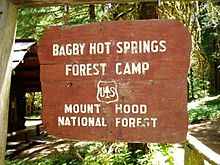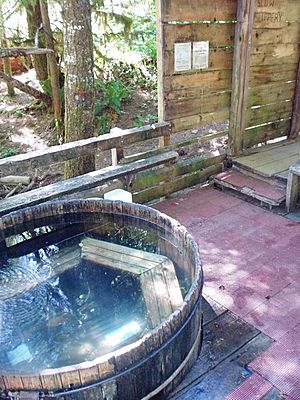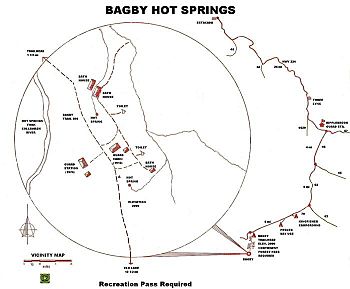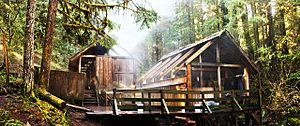Bagby Hot Springs facts for kids
Quick facts for kids Bagby Hot Springs |
|
|---|---|

Bagby USFS Sign
|
|
| Type | National Forest |
| Location | Clackamas County, Oregon, US |
| Operated by | U.S. Forest Service |
| Parking | Forest Service lot 1.5 miles (2.4 km) off-site |
The Bagby Hot Springs are natural hot springs located in the Mount Hood National Forest. They are about 67 miles (108 km) southeast of Portland, Oregon, in the Cascade Mountains. This beautiful area is heavily forested and sits at an elevation of 2,280 feet (695 meters).
Contents
Discovering Bagby Hot Springs
Bagby Hot Springs have a long and interesting history.
Early Use
For hundreds of years, Native Americans used these hot springs. They were a special place for them.
How the Springs Got Their Name
The springs are named after Bob Bagby. He was a prospector and hunter who found the site in 1880.
The Forest Service and the Guard Station
In 1913, the United States Forest Service built a small guard station here. This building was used to house fire patrol crews. These crews helped fight wildfires during the summer.
A new guard station was built in 1974. The original cabin was closed but kept standing. In 2006, the old cabin was fixed up. Today, it is a historic building, but visitors cannot go inside.
Bathhouses for Visitors
A bathhouse was first built at the springs in the 1920s. Sadly, this first bathhouse burned down in 1979.
After that, a group of volunteers called Friends of Bagby (FOB) helped rebuild the bathhouses. Between 1983 and 1986, the Forest Service and FOB worked together. They built three new bathhouses at Bagby.
Since 2011, there has been a small fee to use the hot springs. This fee helps to keep the facilities running and maintained for everyone to enjoy. The bathing facilities at Bagby Hot Springs are still very popular today.
About the Hot Springs Water
Bagby Hot Springs has three main springs and a few smaller ones.
Water Flow and Temperature
The largest spring flows about 24 gallons (91 liters) of water per minute. The water is very hot, around 138 degrees Fahrenheit (59 degrees Celsius).
The other two main springs also produce a lot of hot water. One flows 15 gallons (57 liters) per minute at 136°F (58°C). The other flows 3 gallons (11 liters) per minute at 120°F (49°C).
Natural Minerals in the Water
The water from Bagby springs is full of natural minerals. These include things like silica, sodium, and sulfate.
Facilities at Bagby Hot Springs
Bagby Hot Springs are open every day from 8 AM to 10 PM. There is a $5 fee per person to use the soaking tubs.
How to Pay
You can pay the fee with cash in the parking lot. You can also pay with cash or a credit/debit card at the store in the Ripplebrook Ranger Station.
Important Rules
Camping is not allowed at the hot springs. It is also not allowed along the trail leading to Bagby. Local officers sometimes visit to make sure everyone has a good time.
The wait time for a soaking tub can change. It depends on how many people are visiting. Summer weekends and holidays are usually the busiest times.
Types of Bathhouses
There are three bathhouses at the site for visitors to enjoy.
- Main Bathhouse: This building has five cedar log tubs. Each tub is in its own private room.
- Lower Bathhouse: This one has three small tubs for two people. These are Japanese-style tubs made of yellow pine. It also has a large round tub on an open deck.
- Upper Bathhouse: This bathhouse is about 100 yards (91 m) away from the other two. It has one large round tub on an open deck.
How to Get to Bagby Hot Springs
There is no road that goes directly to Bagby Hot Springs. Visitors must hike to reach the site.
The Trail
You will hike about 1.5-mile (2.4 km) from a Forest Service parking area. The trail is fairly easy to walk. It only goes up about 200 feet (61 m) in elevation.
The Forest Service and volunteers from the Northwest Forest Conservancy help keep the trail in good condition.




